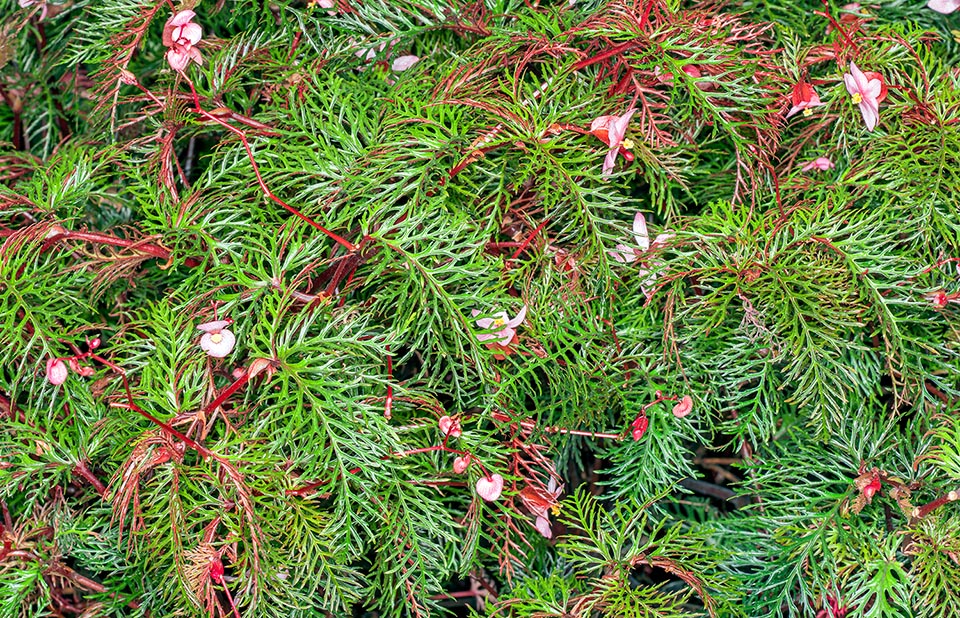Family : Begoniaceae

Text © Pietro Puccio

English translation by Mario Beltramini
The species is native to Papua New Guinea where it grows in the under-wood of the mountain humid forests on rocky soils.
The genus is honoured to the French naturalist and collector Michel Begon (1638-1710), who was governor of the French colonies in the Caribbean; the name of the species is the combination of the Latin adverb ‘bis”= twice, of the adjective “pinnatus, a, um” = pennate and of the verb “findo” = to split, to divide, hence with leaf doubly engraved like a feather.
Common names: fern leaf begonia (English).
The Begonia bipinnatifida J.J.Sm. (1906) is a monoicous perennial herbaceous species, erect, up to about 40 cm tall, ramified, with zig-zagging cylindrical stems, of red colour with enlarged nodes. The leaves, on a 1-2 cm long petiole, are bipinnatifid, with an obliquely oblong-ovate profile, 7-13 cm long and 3-5 cm large, with 12-16 pinnatifid segments of length decreasing towards the apex, of glossy intense green colour above, reddish below.

Native to Papua New Guinea, Begonia bipinnatifida is a perennial herbaceous zig-zagging ramified species about 40 cm tall. Reddish stems and jagged like ferns a suggests the English common name of “Fern leaf begonia”. They are bipinnatifid with the upper part of a nice intense glossy green colour and the lower one recalling the stems © Giuseppe Mazza
Bisexual terminal inflorescences with 1-3 flowers, the male, on an about 1 cm long reddish pedicel, have two reniform tepals, 1 cm long and 1,2 cm broad, whitish with margin tending green, with numerous stamens, 4-5 mm long, united at the base to form a column, and yellow anthers. Female flowers with 5 unequal tepals, oblong to elliptic, of pale pink colour, about 1 cm long and 0,6 cm broad, 3 erect styles, of golden yellow colour, about 4 mm long, stigmata of the same colour, crescent-shaped, and inferior ovary, trialate, trilocular, about 1 cm long and 0,5 cm broad. The fruits are capsules containing several tiny seeds.
It reproduces by seed, but usually and easily by cutting, also leaf-cutting, in spring summer, in a confined environment to maintain a high humidity.
Very decorative species thanks to its foliage, that recalls that of the ferns, evidenced by the contrast of colour between the two pages of the leaf, but of not completely easy cultivation due to its particular requirements.
The ideal environment is that of a very luminous greenhouse, but without direct sun, aerated, with high and constant humidity, 70-90%, and averagely high temperatures, 22-26 °C, without abrupt variations, with lowest minimal winter ones not under the 16 °C, even if it can bear some degree less.
Due to the contained dimensions it is suitable also to terraria with light, humidity and temperature duly regulated, to avoid dangerous excesses, and always slightly moving air in order to avoid humidity stagnations and decrease the possibility of fungal infections, to which is easily subject, and attacks by parasites, favoured by the confined environment, in any case it must be frequently inspected in order to be able to promptly intervene with specific products.
The soil, rich of organic substance, slightly acidic to neutral, must be particularly aerated and draining, renewed as soon as it begins to degrade, the watering to be done carefully, to avoid root rottenness due to water stagnations, allowing the upper layer of the loam to dry up before watering again, in particular in winter when the plant if dormant.
→ To appreciate the biodiversity within the BEGONIACEAE family please click here.
